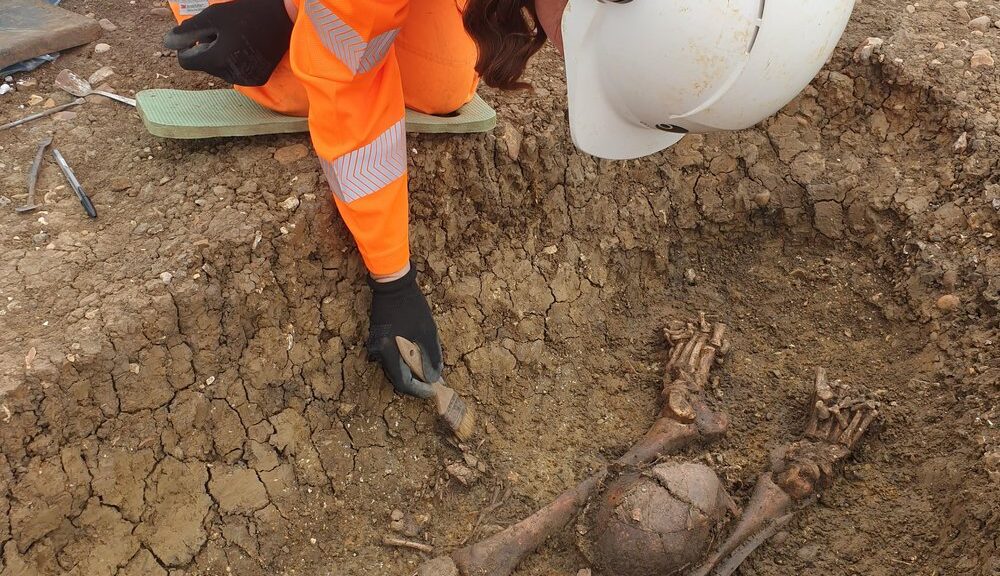Archaeologists Find 40 Beheaded Roman Skeletons With Skulls Between Their Legs
Archaeologists in England have unearthed 40 beheaded skeletons at an ancient Roman burial site while digging along the high-speed rail line near Fleet Marston, just 55 miles northwest of London.

Researchers found the remains while excavating part of a newly discovered 2,000-year-old town, which also included coins, lead weights, brooches, bells and enclosures that once formed part of a road, according to Katy Prickett of BBC News.
The team uncovered the artefacts while work was progressing on the construction of HS2, a major modern railway system that will connect much of the country when completed in 2040, per the Guardian.
“The excavation is significant in both enabling a clear characterization of this Roman town but also a study of many of its inhabitants,” Robert Brown of COPA JV, a consortium of archaeological contractors working with HS2, says in a statement.
For more than a year, Cotswold Archaeology, Oxford Archaeology and Pre-Construct Archaeology (COPA) have worked to excavate the town and burial site. The cemetery, from which 425 skeletons were exhumed, is the largest of its kind in Buckinghamshire, per the Guardian.

About 10 per cent of the skeletons found were decapitated, with the skulls placed between their legs or near their feet, possibly due to their status as criminals or outcasts, say the researchers in the statement. However, they add that such burials were also a “normal, albeit marginal, burial rite” conducted in the late Roman period, dating to between 250-450 C.E.
“Decapitation was one of the four main methods of execution sanctioned by Roman law” and is believed to have been a popular choice among lawmakers across Roman Britain,” Rob Wiseman, an archaeologist at the University of Cambridge who was not involved in the discovery, told Live Science in an email. “Although what the purpose [of that ritual] remained uncertain.”
Often in these cases, scientists are unable to determine if the decapitated bodies had their heads removed before or after death, Wiseman adds, but sometimes skeletons found at similar burials show evidence of being struck from behind by a sharp blade while the person was kneeling.
Aside from the severed heads, the graves don’t appear different from other Roman gravesites. Even under Roman law, the bodies of executed criminals were typically handed over to kin, who traditionally opted for normal burials, Wiseman tells Live Science. One explanation for the placement of the severed heads at Fleet Marston burial is that the relatives of the individuals may have believed that the soul would only transition into the afterlife if the head was placed next to the rest of the body, Wiseman says. Or it could be they feared the corpse would put itself back together and return from death.
The archaeologists state that the number of burials and the development of the settlement suggests the town experienced a “population influx” around the mid-to-late Roman period, due to what may have been an increase in agricultural production. The burial site was divided into two different areas, indicating that the cemetery may have been organized by tribe, family or ethnic grouping, per the statement.
The researchers plan to study the exhumed skeletons over the next few years in hopes of learning more about the lifestyles of ancient Romans, reports Alia Shoaib for Business Insider.

“All human remains uncovered will be treated with dignity, care and respect and our discoveries will be shared with the community,” says Helen Wass, head of heritage at HS2, in the statement. “HS2’s archaeology program seeks to engage with all communities both locally and nationally to share the information and knowledge gained as well as leaving a lasting archival and skills legacy.”
Experts also found 1,200 coins along with several lead weights indicating the town served as a centre for trade, reports BBC News. Additionally, the site contained domestic artefacts, such as pottery, spoons, pins and brooches, as well as gaming dice and bells, suggesting gambling and religious activity occurred at the settlement.
In addition to the artefacts, a team of 50 COPA archaeologists discovered a series of enclosures along Akeman Street, an ancient Roman road linking the town of Verulamium—now St. Albans—with the settlement of Corinium Dobunnorum—now Cirencester—per the HS2 statement. These structures were likely a mix of domestic dwellings and sites of commercial and industrial activity.
Parts of the road were widened, say the scientists, suggesting the area may have been used as a marketplace. The extra room would have provided space for carts and stalls, according to the statement.

Archaeologists say the town was likely an important staging post for travellers and soldiers passing on their way to and from the Roman garrison at what is now Alchester, per BBC News.
The scientists also found evidence of Iron Age enclosures, suggesting the area was used for farming before the town was established. Early in the Roman period, the region was the site of gravel quarrying, possibly used for the construction of Akeman Street, per the statement. The team also discovered a stone-built corn dryer or malting oven, which may have been used for brewing, per the statement.
Fleet Marston is one of more than 100 archaeological sites investigated by HS2 since work began in 2018 on the first phase of track between London and Birmingham, reports the Guardian.
“The HS2 archaeology program has enabled us to learn more about our rich history in Britain,” Wass tells the Guardian. “The large Roman cemetery at Fleet Marston will enable us to gain a detailed insight into the residents of Fleet Marston and the wider Roman Britain landscape.
